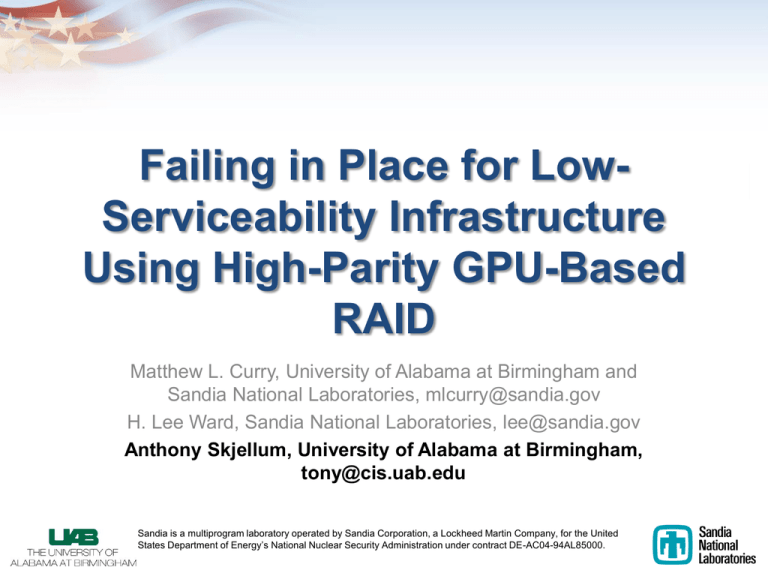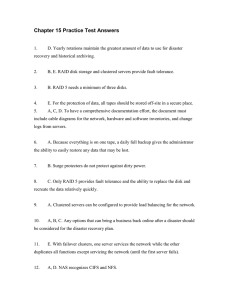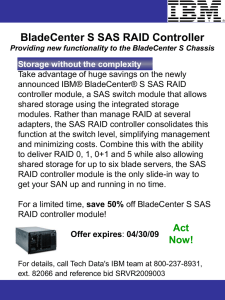Failing in Place for Low- Serviceability Infrastructure Using High-Parity GPU-Based RAID
advertisement

Failing in Place for LowServiceability Infrastructure Using High-Parity GPU-Based RAID Matthew L. Curry, University of Alabama at Birmingham and Sandia National Laboratories, mlcurry@sandia.gov H. Lee Ward, Sandia National Laboratories, lee@sandia.gov Anthony Skjellum, University of Alabama at Birmingham, tony@cis.uab.edu Sandia is a multiprogram laboratory operated by Sandia Corporation, a Lockheed Martin Company, for the United States Department of Energy’s National Nuclear Security Administration under contract DE-AC04-94AL85000. Introduction • RAID increases speed and reliability of disk arrays • Mainstream technology limits fault tolerance to two arbitrary failed disks in volume at a time (RAID 6) • Always-on and busy systems that do not have service periods are at increased risk of failure – Hot spares can decrease rebuild time, but leave installations vulnerable for days at a time • High-parity GPU-based RAID can decrease long-term risk of data loss 2 Motivation: Inaccurate Disk Failure Statistics • Mean Time To Data Loss of RAID often assumes manufacturer statistics are accurate – Disks are 2-10x more likely to fail than manufacturers estimate* – Estimates assume low replacement latency and fast rebuilds… Without load *Bianca Schroeder and Garth A. Gibson. “Disk failures in the real world: What does an MTTF of 1,000,000 hours mean to you?” In Proceedings of the 5th USENIX Conference on File and Storage Technologies, Berkeley, CA, USA, 2007. USENIX Association. 3 Probability of Success (No Error) Motivation: Unrecoverable Read Errors 1 0.9 0.8 0.7 0.6 0.5 0.4 0.3 0.2 0.1 0 0 5 10 15 20 25 30 35 40 45 50 55 60 65 70 75 80 85 Terabytes Read BER = 10^-14 BER = 10^-15 4 BER = 10^-16 90 95 100 Result: Hot Spares Are Inadequate Under Load Probability of Data Loss Within Ten Years 0 100 200 300 1.E+00 1.E-01 RAID 5+0 (4 sets) RAID 6+0 (4 sets) 1.E-02 RAID 1+0 (3-way replication) 1.E-03 1.E-04 Data Capacity (TB, using 2TB Disks) MTTR = One Week, MTTF = 100,000 Hours, Lifetime = 10 years 5 Solution: High-Parity RAID • Use Reed-Solomon Coding to provide much higher fault tolerance – Configure array to tolerate failure of any m disks, where m can vary widely – Analogue: RAID 5 has m=1, RAID 6 has m=2, RAID 6+0 also has m=2 – Spare disks, instead of remaining idle, participate actively in array, eliminating window of vulnerability • This is very computationally expensive – k+m RAID, where k is number of data blocks per stripe and m is number of parity blocks per stripe, requires O(m) operations per byte written – Table lookups, so no vector-based parallelism with x86/x86-64 – Failed disks in array operate in degraded mode, which requires the same computational load for reads as writes 6 Use GPUs to Provide Fast RAID Computations • Reed-Solomon coding accesses a look-up table • NVIDIA CUDA architecture supplies several banks of memory, accessible in parallel • 1.82 look-ups per cycle per SM on average • GeForce GTX 285 has 30 SMs, so can satisfy 55 look-ups per cycle per device – Compare to one per core in x86 processors 7 Compute Core Shared Memory Bank Performance: GeForce GTX 285 vs. Intel Extreme Edition 975 5000 Coding Throughput (MB/s) 4500 4000 3500 GPU m=2 3000 GPU m=3 2500 GPU m=4 2000 CPU m=2 1500 CPU m=3 1000 CPU m=4 500 0 2 6 10 14 18 22 26 30 Number of Data Buffers 8 • GPU capable of providing high bandwidth at 6x-10x CPU speeds • New memory layout and matrix generation algorithm for Reed-Solomon yields equivalent write and degraded read performance A User Space RAID Architecture and Data Flow • GPU computing facilities are inaccessible from kernel space • Provide I/O stack components in user space, accessible via iSCSI – Accessible via loopback interface for directattached storage, as in this study • Alternative: Micro-driver Performance Results RAID Type Linux MD, RAID 0 GPU +4 Write Read GPU +3 GPU +2 0 100 200 300 400 500 600 Throughput (MB/s) • 10 GB streaming read/write operations to a 16disk array • Volumes mounted over loopback interface – stgt version used is bottleneck, later versions have higher performance 10 Advance: GPU-Based RAID • Prototype for general-purpose RAID – Arbitrary parity – High-speed read verification – High-parity configuration for initial hardware deployments • Guard against batch-correlated failures • Flexibility not available with hardware RAID – Lower-bandwidth higher-reliability distributed data stores 11 Future Work • UAB – – – – – Data intensive “active storage” computation apps Computation, Compression within the storage stack NSF-funded AS/RAID testbed (.5 Petabyte) Multi-level RAID architecture, failover, trade studies Actually use the storage (e.g., ~200TB of 500TB) • Sandia – Active/active failover configurations – Multi-level RAID architectures – Encryption within the storage stack • Commercialization 12 Conclusions • RAID reliability is increasingly related to BER • Window of vulnerability during rebuild is dangerous, needs to be eliminated if system stays busy 24x7 – Hot spares are inadequate because of elongated rebuild times under load • High-parity GPU RAID can eliminate window of vulnerability while not harming performance for streaming workload • Fast writes and degraded reads enabled by GPU make this feasible 13



